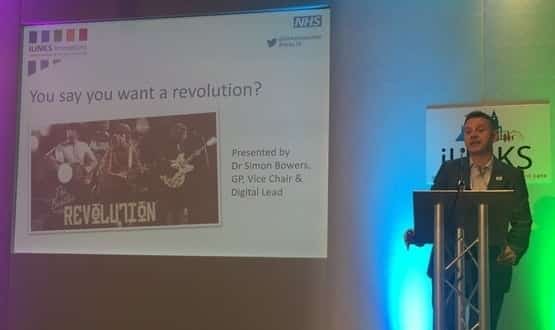You say you want a revolution…
- 28 July 2016

“Smash the fax!” The cry comes from the audience at iLinks Innovations Conference at Aintree Racecourse in Liverpool and is met with smile by the speaker everybody is shouting at, NHS Liverpool Clinical Commissioning Group’s deputy chairman, Dr Simon Bowers.
Earlier in the year, Bowers presided over a “digital disruption clinical summit” at which he invited attendees to destroy a fax machine with a hammer. There were plenty of volunteers. “I think we’ve started something,” he says.
From ‘interoperability’ to virtual meetings
This year was the sixth year that the iLinks Innovation Conference has run, and what started out as a small meeting of enthusiasts (and some sceptics brought along to learn the meaning of the word ‘interoperability’) has grown into something of a regional tradeshow for innovation.
The event was set up to bring together organisations involved in the iLinks informatics transformation programme to link health and social care information exchanges across North Merseyside, and to explain to frontline staff how this might improve patient outcomes and pathways through technology.
That idea has certainly worked. In the past year alone, nearly 6 million records have been shared in Merseyside and 164 organisations have just signed up to one information sharing agreement, replacing the more than 2,000 different agreements that had been put in place across the region as the programme expanded.
In June, the programme also moved to the next phase, with Merseyside submitting its local digital road map to NHS England. One of many but, its authors insist, likely one of the best.
The road map covers Halton, Knowsley, Liverpool, South Sefton, Southport and Formby and St Helens; an area with a population of around 1.2 million people. Six CCGs and 13 provider trusts have signed-up to the plan.
As well as a big focus on greater sharing, and shedding old ineffective technology, the plan also looks forward at some exciting new technology. Innovations that Bowers calls “like something out Star Trek”.
Sensors and zen gardens
While the fax stubbornly persists, in Liverpool they are playing with virtual reality.
On the exhibition floor of the conference, a rotation of health professionals sits perched on high stools with virtual reality headsets strapped to their faces.
The software they are using, Liverpool-based Vtime, will be tested in clinical settings later this year for hosting virtual multi-disciplinary meetings, treating social isolation and teen patient therapy sessions.
It’s not entirely clear that it will work, but in Liverpool they not going to die waiting. “There is no time to let the technology bed in,” Bowers says. “If there is a possibility that this could improve outcomes and save money we must use it.”
Testing in also planned for sensors that can track an elderly and frail patient’s movements around the house and alert their GPs when there is a change in the patient’s gait; indicating an increased risk of a fall.
If it works, is affordable and scalable, the benefits are obvious and potentially huge. Fewer fractures, few hospital visits, better quality of life for older patients.
Other innovations that will be trialled included a smart bandage that sends a district nurse a text alert when a patient’s dressing needs changing and tiny sensors that can monitor a patient’s hydration at a molecular level.
Bowers says all of these innovations are being tested in the next 24 months, providing they can secure funding, something it is hoped the local digital road maps, and the overlaying sustainability and transformation plans, will help achieve.
“[These] are things that will make you thing you are in Star Trek. Potentially care changing bits of gear that are going to be available, going to the market, testing in our city.”
Improvement on the cheap
But many of the innovations being touted at the conference are more mundane and, importantly, cheaper. It often comes down to fixes for a system that have become needlessly complicated for reasons no one can quite remember.
Bowers describes this as cutting through the maze, using technology to create a simpler path for clinicians and patients. “None of these things require us to buy grand new kits, write a big fat cheque to Emis, or wait half a year for new software development.”
At Aintree Neighbourhood, GPs and community nurses have used existing functionality in the Emis system that most GPs in the area use to reduce the patient referral pathway from seven to three steps.
Dr Mark Wigglesworth, who led the project, said this was achieved by giving community matrons and district nurses access to Emis health records and using the Emis task function to communicate and collaborate on patient care. “This means time saving, it means less administrative work, it means improved communication.”
Some 35,000 patients in Aintree are now being managed through this new pathway, but Wigglesworth hopes it will be adopted across Liverpool. “This is all within Emis already. There for anyone to use it. It’s not about new technology; it’s about governance and deciding who can see what.”
Much of the work around information sharing is also focused on organisational change rather than the technology. Stripping back processes, simplifying them, and then using existing technology to make them work.
Bowers said getting 164 organisations to agree to a single model of information sharing was huge, removing friction not by dropping a few million pounds on a new system but by agreeing to shared set of principles.
“It more of the simplify, simplify, simplify.”
“The homework”
Most of the 90-odd local digital roadmaps that healthcare economies had to get together by 30 June are now sitting with NHS England; where will remain under wraps for months and perhaps until the sustainability and transformation plans start to emerge in October.
But at the iLinks conference, they were already handing out copies of Merseyside roadmap. Bowers and others involved in its formation are clearly proud of the document, something they say could have easily been treated as unwelcome NHS England “homework”.
“I think this is a very impressive piece of work. The Merseyside plan is being bandied around to other trusts, that perhaps aren’t doing so well, as best practice.”
The three over-reaching goals of the plan are simple; digital empowering individuals, a connected health and social care economy, and exploiting the digital revolution.
Under this, there is a list of specific goals to be reached by 2021. These include moving to a single electronic patient record system for all acute trusts, which the area is already attempting with three of its big hospital trusts making a joint bid for a new EPR.
Another goal, more on the digital revolution front, is using predictive analytics to pinpoint high needs patients early and target care.
Underpinning all of this, the roadmap sets out ten principles that all the organisations involved have pledged to uphold, including simple design, default sharing and digital inclusion of the whole population.
Building on strong foundations
The roadmap builds on work developed under the iLinks programme, and particularly the iLinks strategy launched in 2014.
It also reveals a health and care economy that is digitally mature at a primary and community level, but still patchy and fragmented in the acute sector.
Some of the more ambitious changes also rely on central funding, including from the £1.8 billion Sustainability and Transformation Fund, that is looking increasingly under pressure as the NHS’s financial worsen.
Among the “limiting factors” identified in the roadmap is the “challenging financial climate”. Other factors listed included a reluctance from organisations and suppliers to embrace a more open approach and a “plethora of systems in use that do not talk to one another”.
However, the financial constraints facing the road map ambitions were given little time at the conference, where the talk was firmly focused on sharing and futuristic technology. And the dread fax, of course which, according to the roadmap, will be “eradicated” by 2021.




